Setting up a case with approval
Example
This chapter covers step-by-step procedure of setting up a typical approval case: a leave request in the [Documents] section.
•Each record with the “Approval” type is submitted for approval automatically, right after a new record is saved.
•First, an HR employee must approve the request.
•Once approved by the HR, the request is submitted for approval by the corresponding department manager.
•Approvers will receive email notifications that a new record awaits their approval. The Employees who submit requests for approval shall receive email notifications about approval results.
•If the approval has been denied by HR, the case transitions to the [Preparation] stage, at which the employee must revise the request. If the approval has been denied by the department manager, the case transitions to the [Canceled] stage.
•If the request is approved by the department manager, the case transitions to the [Completed] stage.
•The [Completed] and [Canceled] stages are final. Set up the approval case as shown on Fig. 1.
Attention
This is one of the many ways to set up an approval case. Not all fields and values used are available in the base Creatio configuration. You can set up additional section fields in the Section wizard. Read more>>>
Before creating and configuring an approval business process, make sure that the [Enable approval in section] checkbox is selected for that section in the section wizard. Read more>>>
Fig. 1 Case for leave request approval

Case for leave request approval
Open the list of cases in the [Documents] section by clicking [Set up section cases] in the [View] menu (Fig. 2).
1.In the list of cases, select “Status” in the [Which column to build the stages by?] field. As a result, the case stages will be defined by the document status.
2.In the [Which column determines which case to use with a record?] field, select “Type”. As a result, the case will apply only to documents of specific type (i.e., “Request”).
Fig. 2 Case list of the [Documents] section

Click the [New case] button to open the Case Designer. Here you will need to set up:
-
Case parameters.
-
Case sequence.
-
Activities on each case stage.
Setting up case parameters
The case parameters are set up in the case setup area (Fig. 3).
Note
Click  to open case properties.
to open case properties.
1.Specify case title (i.e., “Request processing”).
2.Optionally, populate the [Description] field with additional information for anyone who may edit this case.
3.In the [Use this case with records where:] area, click  and select “Request”. As a result, the case will apply to all documents of the “Request” type.
and select “Request”. As a result, the case will apply to all documents of the “Request” type.
Attention
This is one of the many ways to set up an approval case. Not all fields and values used are available in the base Creatio configuration. You can add document types to the [Document types] lookup. Working with lookups is covered in a separate article.
4.The [Section], [Stage column], [Code], [Package], [Active] and [Actual version] fields will be populated automatically. For more information about case properties, see the “Case Designer properties” article.
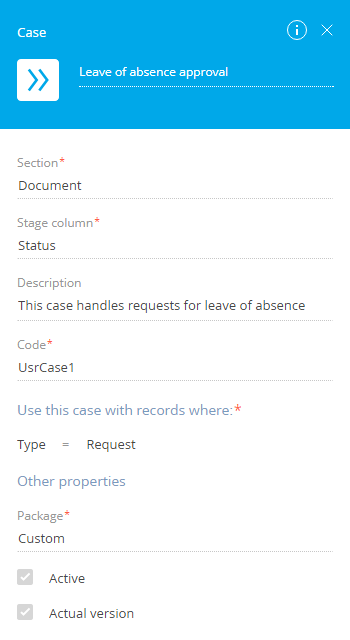
Setting up case stages
Use the stages panel to set up the case workflow. The lave request approval case will have 5 stages that correspond to the values in the [Status] field in the [Documents] section. Use the  button to add case stages: [Draft], [Approval], [Completed] and [Canceled]. Set up stage properties and steps to complete at each stage. We will use the first stage as an example.
button to add case stages: [Draft], [Approval], [Completed] and [Canceled]. Set up stage properties and steps to complete at each stage. We will use the first stage as an example.
1.Click the first stage to open its setup area (Fig. 4).
2.Enter stage name.
3.Select the corresponding document stage in the [Stage value in the lookup] field. You can add document stages directly from the Case Designer by typing in the new stage name. Be sure to save the case each time you add a new lookup value this way.
field. You can add document stages directly from the Case Designer by typing in the new stage name. Be sure to save the case each time you add a new lookup value this way.
4.All other case stages will be automatically added to the [Possible next stages] area. Remove all stages from the list, except for the [Approval] and [Canceled] stages.
5.All other case stages will be automatically added to the [Possible previous stages] area. Remove all stages, except for [Approval] from the list. If the approval is denied, the case will transition back to the [Draft] stage.
6.In the [Automatic transition to next case stage] field, select “If required steps are completed”.
7.In the [Additional settings] area, select a color for this stage.
8.Leave the [Group with another stage] checkbox cleared. Grouped stages will display as one for the case user. Clicking a grouped stage will open a menu with all stages in the group. Note that this checkbox must be selected for the [Canceled] stage, which must be grouped with the [Completed] stage.
Fig. 4 [Draft] case stage properties
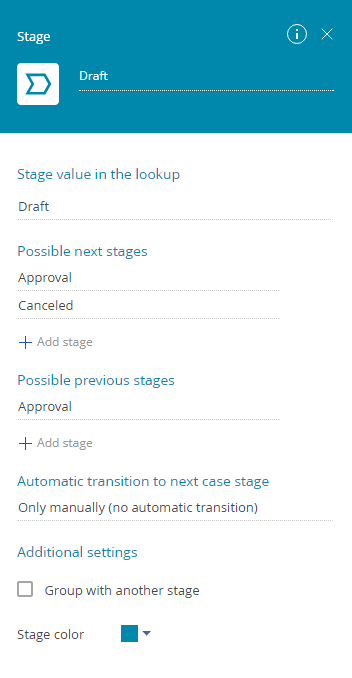
Set up other stage properties in a similar way: [Approval] (Fig. 5), [Completed] (Fig. 6), Canceled (Fig. 7) and [Archive] (Fig. 8).
Fig. 5 The [Approval] stage parameters

Fig. 6 The [Completed] stage parameters

Note
The [Completed] and [Canceled] stages are mutually exclusive, and are therefore grouped. The grouping is configured in the properties of the [Canceled] stage. In the setup area of the [Completed] stage, a  icon is displayed next to the [Group with another stage] checkbox. If you hover cursor over the icon, a tool tip will appear, indicating that the stage is already grouped.
icon is displayed next to the [Group with another stage] checkbox. If you hover cursor over the icon, a tool tip will appear, indicating that the stage is already grouped.
Fig. 7 The [Canceled] stage parameters
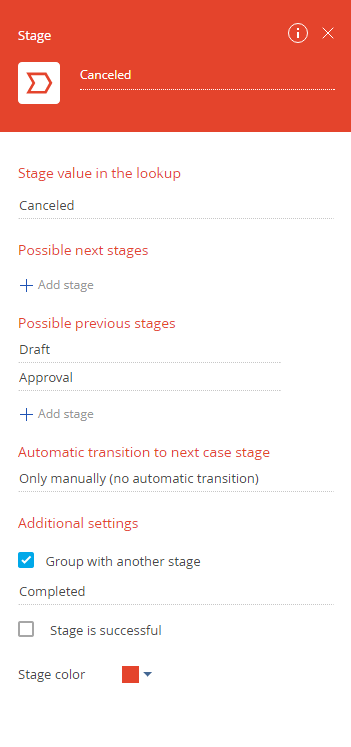
Fig. 8 The [Archive] stage parameters
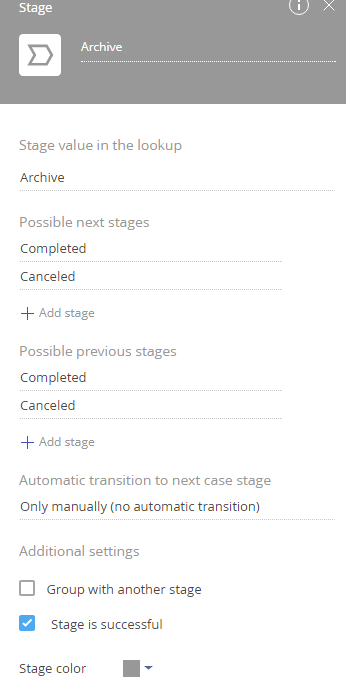
Setting up case stage steps
Set up the steps of the [Draft] stage. To do this:
1.Click the  icon below the [Draft] stage in the Case Designer working area. Select [Open edit page] element. As a result, the document page will open on the [Draft] stage.
icon below the [Draft] stage in the Case Designer working area. Select [Open edit page] element. As a result, the document page will open on the [Draft] stage.
2.Enter name of the new case element and press Enter. Click the added element to view its setup area.
3.In the [Which page to open?] field, select “Document“.
field, select “Document“.
4.In the [Editing mode] field, select “Edit existing record“. [Record Id] field will display below.
5.In the [Record Id] field, click ![]() and select “Main record column”. Choose the [Id] column. As a result, the case will open the document record for which the case instance is run.
and select “Main record column”. Choose the [Id] column. As a result, the case will open the document record for which the case instance is run.
6.In the [Who fills in the page?] field, the current user contact is specified by default. Click ![]() to change this value, if needed.
to change this value, if needed.
7.In the [Recommendation for filling in the page] field, list the actions that the user must perform on the opened document page, such as “Specify type of leave and exact dates”. This text will be displayed on the new document page.
8.In the [Hint for user] field, enter additional information for the user. For example, you can use this field to specify the maximum number of available vacation days or add a reminder to adjust the vacation with the head of the department before filling in the request.
9.[When is the element considered complete?] – you can optionally select “If the record matches conditions” to consider the case element complete when the record matches required conditions (certain fields are filled, etc.).
10.Otherwise, leave “Immediately after saving the record” in the [When is the element considered complete?] field (Fig. 9). To do this:
a.Click the [Add condition] button and select the [Vocation type] column as required.
b.Select the [Number of vacation days] column as required.
Fig. 9 Setting up filter conditions
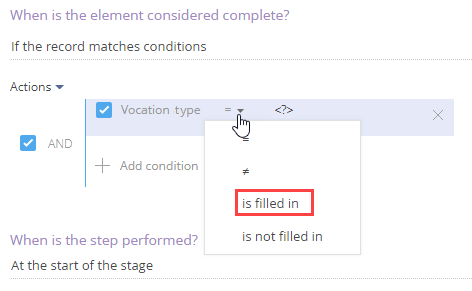
11.The “At the start of the stage” value will be displayed by default in the [When is the step performed?] field. After the case transition to the [Draft] stage, the task for filling the application will be created. The task will be displayed on the application page which is processed by the case.
12.In the [Step type] field specify the step as required.
As a result, the settings for the case element will look like this (Fig. 10):
Fig. 10 Properties of the “Fill application” element
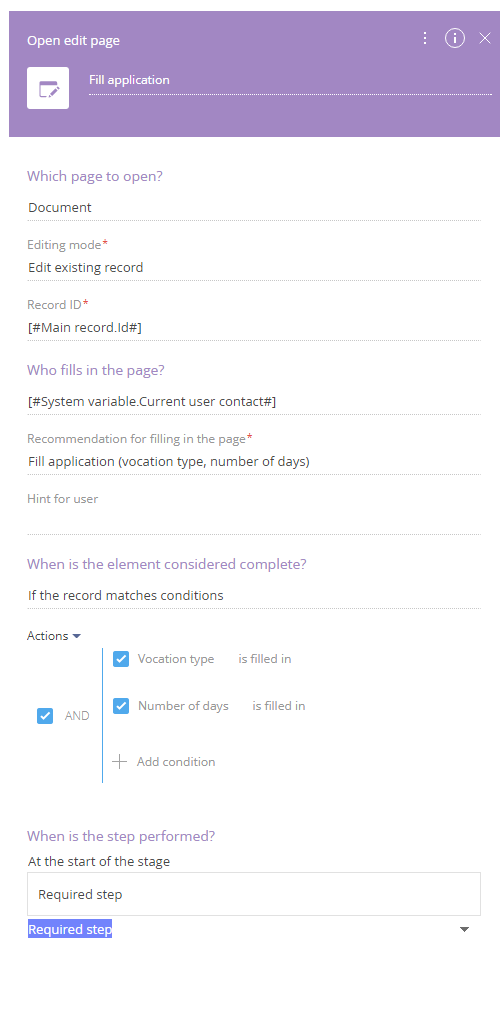
Set up the steps of the [Approval] stage.
1.Add a new Approval case element on the Case Designer working area. Enter name of the new case element (i.e., “HR approval”) and press Enter. Populate the case element parameters.
2.In the [When is the step performed?] field the “At the start of the stage” value will be displayed by default.
3.In the [Step type] field specify the step as required.
4.The “Approval required” value will automatically display In the [Approval purpose] field. If needed, modify the value in the [Approval purpose] field.
5.The value in the [Approval section] field should be “Documents” (the section, for which the case is being set up). This will be set by default if approvals are enabled in the [Documents] section.
Note
If you cannot find the [Document] object in the list, the approval procedure might be disabled for the [Documents] section in the Section wizard. More information about approvals is available in a separate article.
6.The [Record Id] field will be set to the record for which the case is run.
7.In the [Approver] field, select “Role”.
8.In the [Role] field, select “Lookup value” option and choose the value that corresponds to the HR department from the the “Roles (view)” lookup. All employees in the selected role will be able to process this approval.
9.In the [Send email notification] area, configure automatic email notifications for the approvers and the document owner employee.
a.Select the [Notify that approval is required] checkbox.
b.In the [Email template] field, click  and select an email template from the [Email message template] lookup.
and select an email template from the [Email message template] lookup.
c.Select the [Notify about the approval result] checkbox.
d.In the [Recipient] field, click the  button and select “Main record column” option. In the opened [Select column] window, click [+] and select the [Owner] column. In the appeared [Column] field, select the [Email] column of the document owner’s contact record and click [Select]. The value in the [Recipient] field should now be “[#Main record.Owner.Email#]”.
button and select “Main record column” option. In the opened [Select column] window, click [+] and select the [Owner] column. In the appeared [Column] field, select the [Email] column of the document owner’s contact record and click [Select]. The value in the [Recipient] field should now be “[#Main record.Owner.Email#]”.
e.In the [Email template] field, click  and select an email template from the [Email message template] lookup.
and select an email template from the [Email message template] lookup.
Attention
Set up the mailbox for email notifications in the [Mailbox for sending email with information on approval] system setting. Access the system setting in the Process Designer by clicking the  button in the [Send email notification] area.
button in the [Send email notification] area.
Note
Create email templates in the content designer, using the [Approvals in the Documents section] object. The approval objects are created automatically, when you select the [Enable approval in section] checkbox in the section wizard. For example, if you select the [Enable approval in section] checkbox in the [Documents] section wizard, a new object “Approvals in section Document” will be created. If the lookup of the [Enable approval in section] does not contain the template you need, click  in the right part of the field to add a new email template. The process of creating an email template is described in a separate article.
in the right part of the field to add a new email template. The process of creating an email template is described in a separate article.
10.Select the [Ignore errors on sending] checkbox.
11.In the [Change stage after element is completed] area, set the following condition: [If result] – “Negative”; [Set stage to] – “Draft”.
Note
There is no need to set stage transition for positive approval result in this case, as the case will need to proceed to the next step within the same stage.
As a result, the settings for the case element will look like this (Fig. 11):
Fig. 11 “HR approval” case element setup area

1.Add another [Approval] element to the [Approval] stage. Enter name of the new case element (i.e., “Manager’s approval”) and press Enter. The properties of this case element will be the same as the ones of the “HR approval” element, with the exception of the values in the [When is the step performed?], [Approver] and [Change stage after element is completed] properties.
2.In the [When is the step performed?] field, select “After the previous step is complete”.
3.In the [Perform after step] field, select “HR approval” (if the “HR approval” is the only preceding element, it will be selected by default).
4.In the [Approver] field, select “Employee's manager”.
5.In the [Employee] field, click ![]() and select “Main record column”. In the opened column selection window, select the [Owner] column. As a result, whoever is specified as the manager of the employee submitting a leave request, will have to approve it.
and select “Main record column”. In the opened column selection window, select the [Owner] column. As a result, whoever is specified as the manager of the employee submitting a leave request, will have to approve it.
Attention
Please note that not all mentioned objects, fields and values may be available by default in your Creatio configuration. You can set up additional section fields in the Section wizard. Read more>>>
6.In the [Change stage after element is completed] area, set up the following stage transitions:
a.[If result] – “Negative”; [Set stage to] – “Canceled”. As a result, if the request is denied by the employee’s manager, the case transitions to the [Canceled] stage.
b.Click  and add another condition: [If result] – “Positive”; [Set stage to] – “Completed”. As a result, if the request is approved by the employee’s manager, the case transitions to the [Completed] stage.
and add another condition: [If result] – “Positive”; [Set stage to] – “Completed”. As a result, if the request is approved by the employee’s manager, the case transitions to the [Completed] stage.
7.The remaining properties of the “Manager’s approval” case element match those of the “HR approval” element.
As a result, the settings for the case element will look like this (Fig. 12):
Fig. 12 “Manager’s approval” case element setup area

At the [Completed] case stage, set up timer before the document status is changed to “Archive”.
1.Add a new [Subprocess] case element on the Case Designer working area on the [Completed] stage. Enter the name as “Term of the application relevance” (Fig. 14).
2.In the [Which process to run?] field click the  button and select a business process of transfer application to the archive. If the business process is disabled in the list, click the
button and select a business process of transfer application to the archive. If the business process is disabled in the list, click the  button to add it.
button to add it.
Diagram of the business process of transfer application to the archive is provided on the Fig. 13.
The [Simple start event] and [Wait for timer] process elements – the process will start after 15 seconds after transition the case to the [Completed] stage.
The [Modify data] element will change the status of the completed to “Archive”.
Fig. 13 Business process diagram
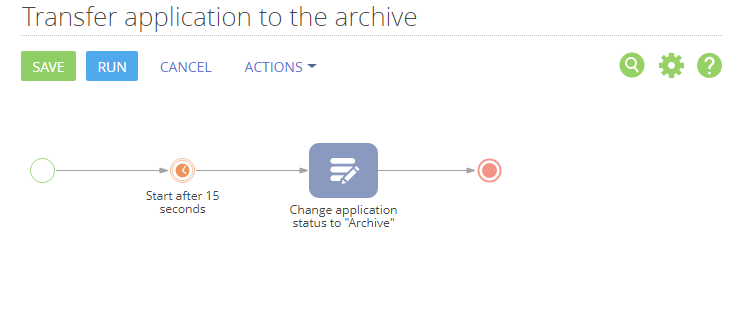
To transfer the application by which the case is running, you should set up transfer of a main record parameter from the case to the process. In our case, the main record is a document and the parameter which getting is to be configured is the document ID. Perform configuration in the Process Designer if the pass of the parameter is not set up. To do this:
a.Open the designer of the process of transfer application to the archive by clicking the  button at the [Which process to run] field.
button at the [Which process to run] field.
b.Double click on the designer workspace to display the edit page of the process parameters.
c.Click the [Add parameter] button on the [Parameters] tab.
d.Select the “Lookup” in the list of the parameter types and specify the “Document” value in the [Lookup] field.
e.Save the changes.
Note
The procedure of business process creation is described in a separate article.
3.Return to the Case Designer to the configuration of the “The term of the application relevance” element properties. After you specify the process in the [Which process to run] field the parameter described above will be displayed in the [Process parameters] area.
4.The “At the start of the stage” value will be displayed by default in the [When is the step performed?] field.
5.The “Optional step” will be displayed in the [Step type] field. You can make it required, if necessary.
Fig. 14 “The term of the application relevance” element properties

Save all changes made in the Case Designer.
Case execution
As a result, all documents of the “Request” type will be processed according to the “Leave of absence approval” case (Fig. 15). As soon as an employee who created a request clicks the [Approval] stage, the document is submitted for approval to HR. If HR denies the approval, the document status is set back to “Draft”. If HR approves the document, it is submitted for employee's manager approval. If the manager denies the approval, the document status is set to “Canceled”. If the manager approves the request, the document status is set to “Completed”.
Fig. 15 Case for leave request approval
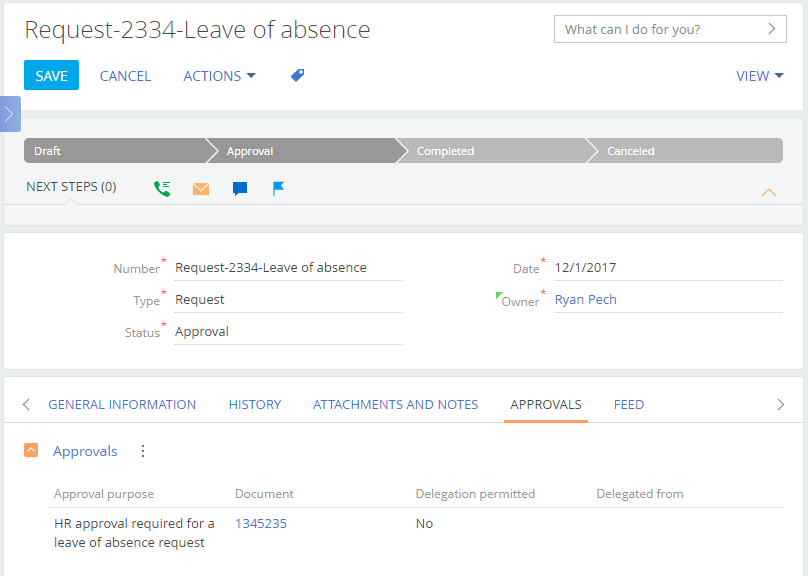
See also






